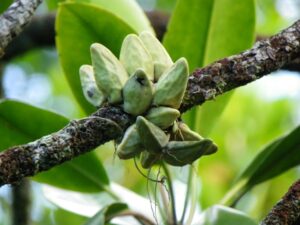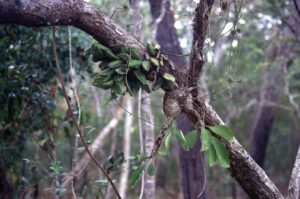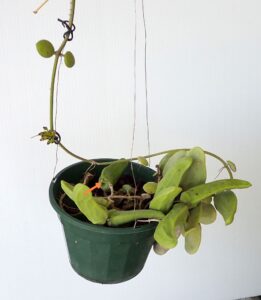
Dischidia major (Apocynaceae) is a strange-looking tropical plant, native to Queensland (Cape York) and also occuring in some Asian countries. It naturally grows as an epiphyte, twining around tree trunks and branches, as in the photos above and below.

Dischidia major , sometimes called “Rattle Skulls”, has the unusual habit of bearing two distinct types of leaves at the same time. It has small, almost circular leaves growing in opposite pairs, widely spaced along its twining stems. It also has dense clusters of large, hollow, tongue-shaped leaves.

At our NPQ Townsville meeting this month, we had a close look at a potted Dischidia major grown by one of our members. We discovered each hollow leaf has an almost-hidden entrance at its base, marked by the arrow in the photo above. So what was inside? We cut open a leaf to find out – photo below.

This leaf was empty, except for roots emerging near the petiole and spreading inside the hollow leaf. However, researchers have found wild-growing Dischidia major plants typically have certain species of arboreal ants nesting in their hollow leaves. Apparently the ants benefit from a secure shelter and their waste accumulates inside the leaf together with condensed moisture.
As an epiphyte, Dischidia major does not have the opportunity to absorb nutrients from the earth. However, when it hosts resident ants, their waste creates a small private compost heap in each occupied leaf, from which the plant’s interior roots take up nutrients – a very neat symbiosis!
In cultivation Dischidia major needs very good drainage (a chunky orchid mix is suitable) and intermittent watering. Provided the plant has a sheltered spot with bright indirect light, it grows well in Townsville even though there may be no ants of the right species to occupy its leaves. The plant brought to our meeting even had flowers emerging from its twining stem (photo above, left side above the rim of the pot).
Botanical details are available at https://apps.lucidcentral.org/rainforest/text/entities/dischidia_major.htm